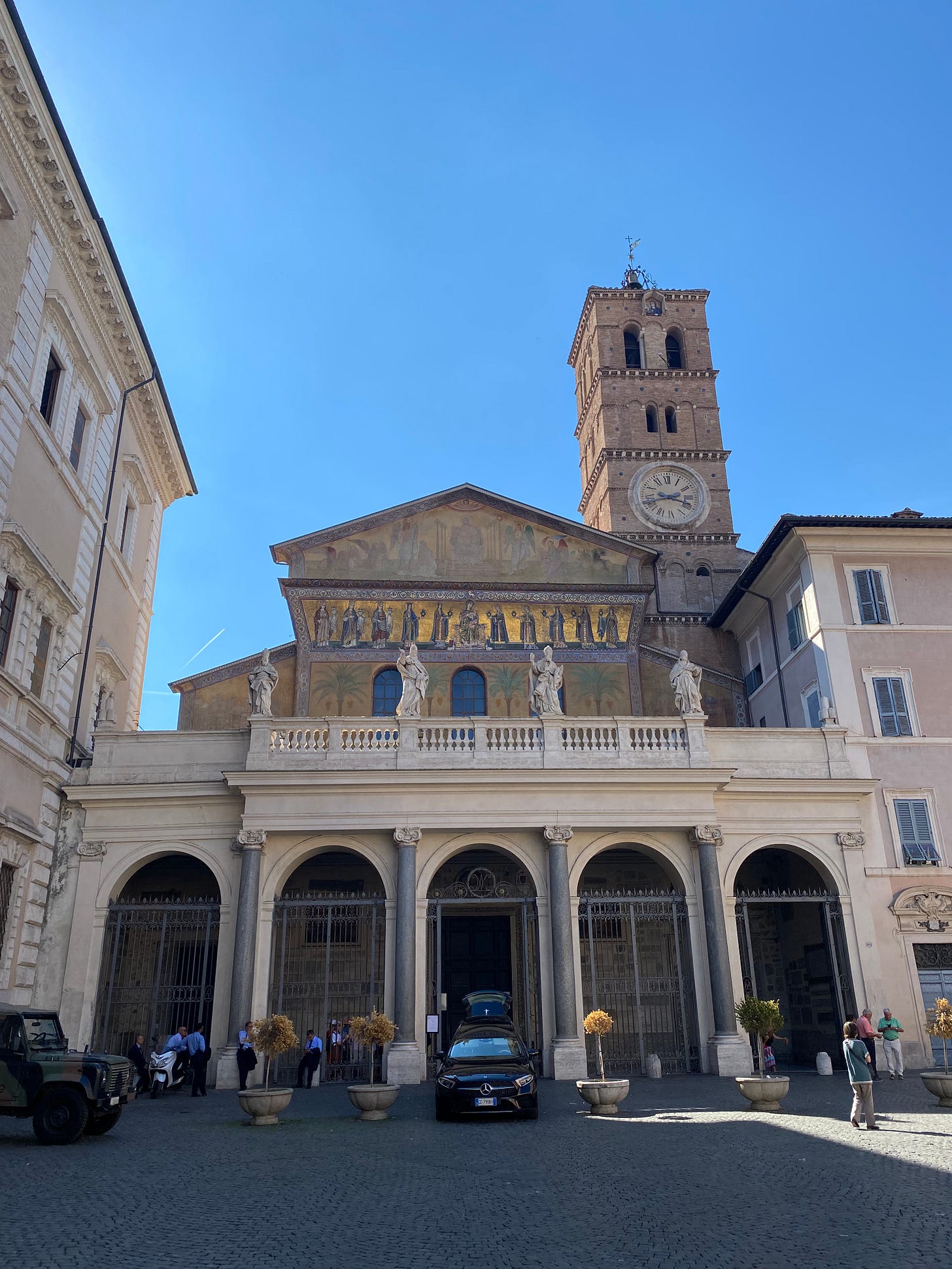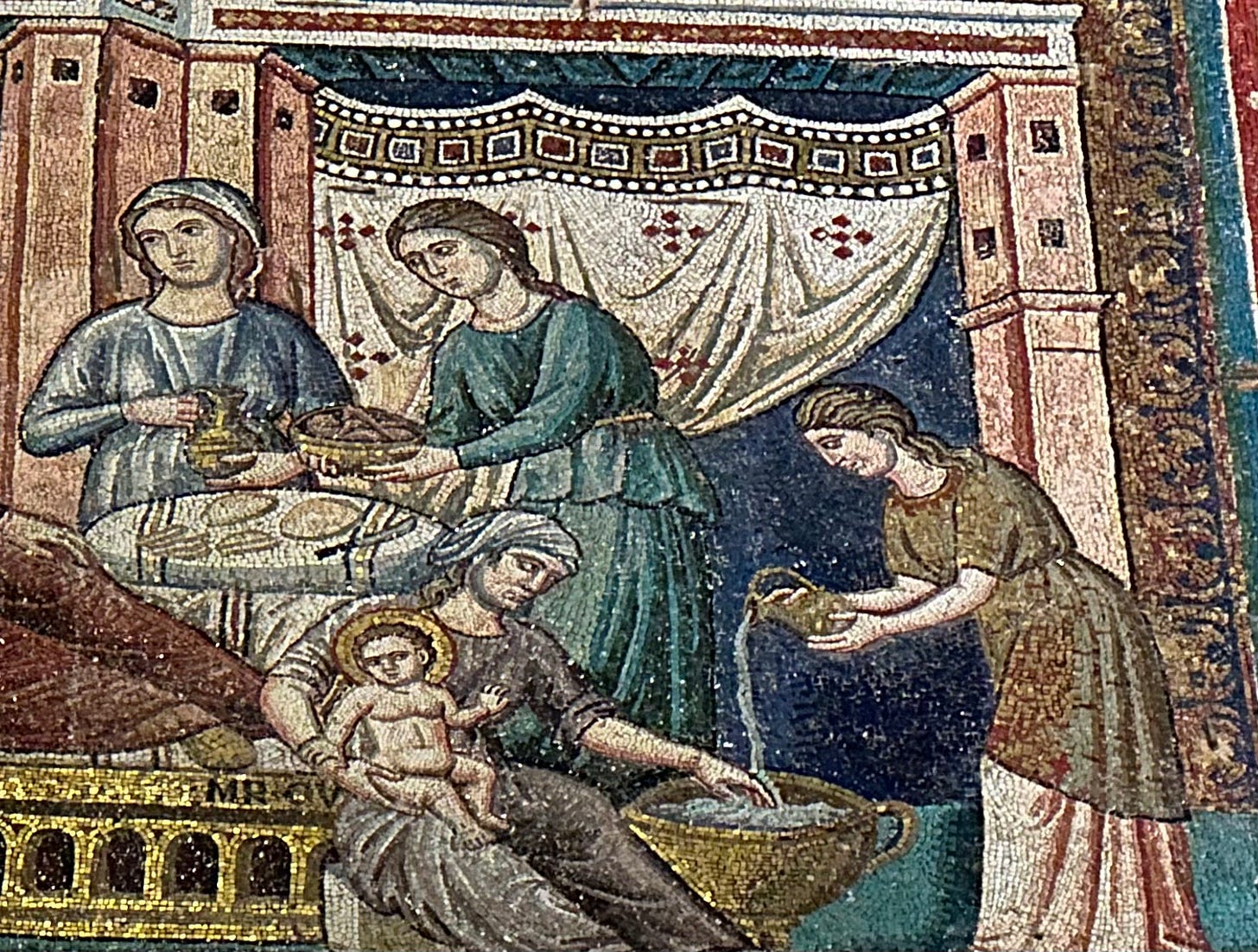Gleaming in the Gloaming: Roman Church Mosaics IV
Pietro Cavallini and the first whisperings of the Renaissance at Santa Maria in Trastevere
Last time I spoke of mosaics here it was of those at Santa Prassede. They belong to the early ninth century renovatio. This was a revival of Rome’s imperial ambitions; a sort of mini-Renaissance born from the relative peace and resultant prosperity of the support for the papal states of Charlemagne, King of the Franks.
Almost five centuries after the reign of Charlemagne, the first whisperings of what we now call the Renaissance can also be seen in mosaic in Rome. In the Augustan “regione” of Trans Tiberim, literally “across the Tiber” (which became “Trastevere” in Italian), the oldest foundation of any church in the city dedicated to the Virgin can be found. Legend tells of a fountain of oil which burst forth and which was considered by early Christians to have prophesied the birth of Christ.
In the middle of the fourth century, not long after Constantine’s Edict of Milan had decriminalised Christianity, a church was dedicated. It was subsequently entirely rebuilt on its original footprint in the twelfth century, built with columns of Egyptian granite repurposed from the Baths of Caracalla. The apse of the new church was decorated with glittering gilded mosaics showing the Virgin crowned as the Queen of Heaven by Christ.

In the last years of the thirteenth century, Pietro Cavallini was called to work at the church on a mosaic cycle below the apse showing the life of the Virgin. Cavallini is, as I mentioned in this post about the almost exactly contemporary frescoes at nearby Santa Cecilia in Trastevere, not as famous as he should be.

The Florentine-centric art history shaped by Vasari tends, with characteristic campanilismo, to favour Giotto as the sole great innovator of the late thirteenth/early fourteenth centuries.

However we can see in the work of both Cavallini and Giotto the crystallization of a moment in which the humanist philosophical impulse to put mankind at the centre of the universe saw a move away from the “otherness” of so much medieval religious art. It coincided with the representation of religious scenes played out in increasingly plausible perspectival settings, and an ever more enthusiastic study of the art of antiquity. If three-dimensional spaces offered recognisable locations within which the human aspect of religious scenes could begin to come to the fore, then the study of antiquity gave a sort of temporal, historical, perspective.
In his mosaic cycle at Santa Maria, Pietro Cavallini offers a fabulously precocious glimpse into this moment and shrugs off, seemingly without effort, the unwieldy, heavily pixelated, nature of the medium. We see the birth of the Virgin in the first panel. St Anne reclines on a bed, every inch the Roman matron, while the infant Mary is identifiable by her halo in the foreground.
To the right we are shown the most exquisite domestic vignette: a meal is being served to St Anne after her exertions; the folds of a hastily tied curtain billow in the background; an attendant woman pours water into a basin, presumably to bathe the infant. Cavallini invites us to imagine the infant Mary, who will be the mother of God, as a baby requiring bathing; that’s quite something.
My other favourite panel is the second, the scene of the Annunciation. The distinctly avian wings of Gabriel sprout from his toga, the instant of his arrival announced by the fluttering tale of the material. Above the stern Byzantine features of Christ appear in a hole in the gilded backdrop, an opening in the heavens, and a dove dive bombs towards Mary on rays of light. The Virgin sits, robed in blue, one hand holding the book she has been reading the other pressed to her chest in surprise, her body slightly recoiling from the drama of the news she is being given. She is sitting in an eminently solid sort of throne-like building, which is at a slight three-quarter angle. Though the details are often swallowed by the gloaming, Cavallini’s attention to detail is extraordinary.
As a short-sighted person I wonder what visitors of the fourteenth century would have seen of these details? They were after all without the benefits of opticians, electric lights, or a camera with a powerful zoom. But whether anyone would have noticed or not, the detail I think of as Cavallini’s great triumph is there: above the side arches the cross vaults, and the coffering of the ceilings above, are also realised with an accurately perspectival three quarter angle. If you know where to look, the first whisperings of the Renaissance in Rome are lurking high up in a gilded apse in Trastevere.








Will look at these fabulous mosaics with new eyes after reading this. Thank you!
I'll be in Rome for a month, starting January 15th. Would you please let me know about any of your planned tours I might be able to join or arrange a tour.